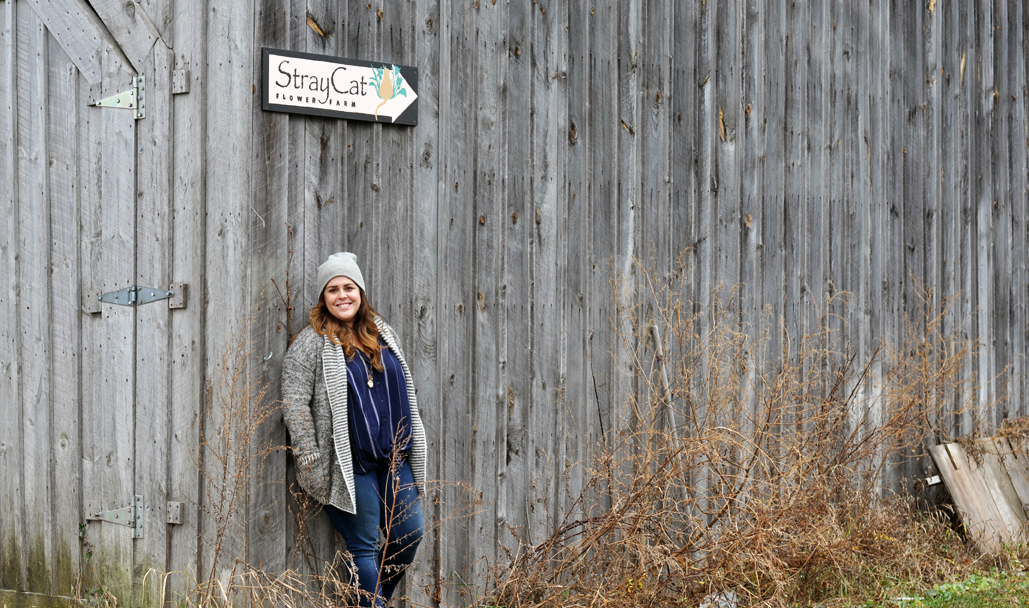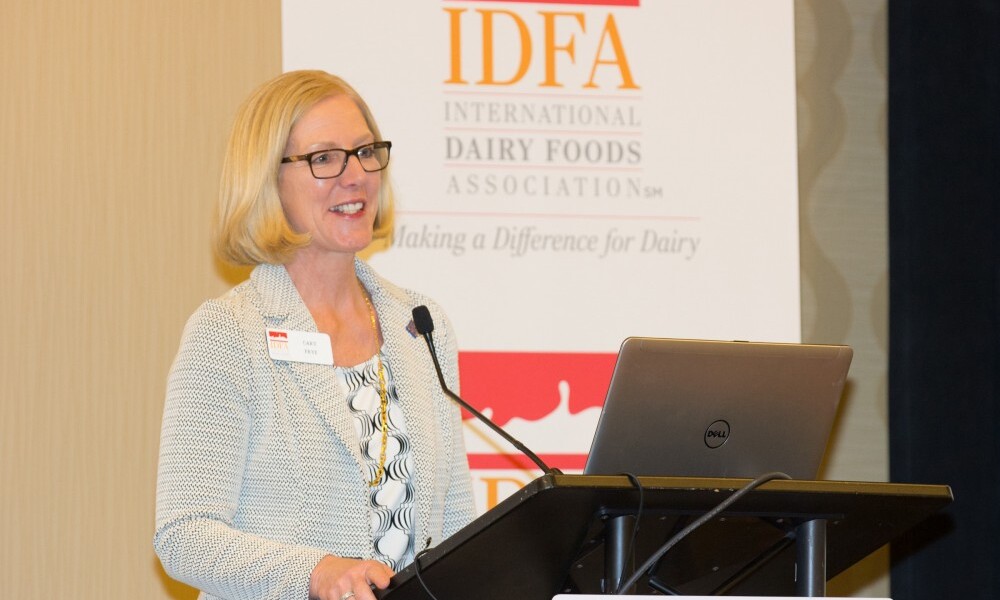By Sarah Tuff Dunn
Of the millions of profile titles on LinkedIn, the one that belongs to Kate McNellis is one of the most poetic: Flower farmer at Stray Cat Flower Farm.
Dig a little deeper, however, and discover that McNellis, who graduated from UVM in 2000 with a degree in environmental studies, wasn’t always toiling in the soil. Instead, she was trimming garments for fashion designer Nanette Lepore, sketching swimwear for Aeropostale, and styling for Victoria’s Secret.
![]() The UVM alumna might have continued living the Manhattan and high-fashion life by the book had it not been for stumbling upon a book by Barbara Kingsolver that inspired her to ditch her clothes-bound life and return to UVM for the Farmer Training Program.
The UVM alumna might have continued living the Manhattan and high-fashion life by the book had it not been for stumbling upon a book by Barbara Kingsolver that inspired her to ditch her clothes-bound life and return to UVM for the Farmer Training Program.
We talked to McNellis to learn what grew out of that creative career change.
Tell me how you first got into fashion—did you do Fashion Plates as a kid?
I loved Fashion Plates as a kid! My Barbie had a pretty amazing wardrobe, as well. My mom also taught me to sew when I was pretty young, and I was always pretty crafty. It was after I graduated UVM and had moved to San Diego, California, when I found myself wanting to do something more creative—and fell back on my love of sewing and making jewelry. So, ready for a change, I applied to the Parsons School of Design and was accepted—so back to the East Coast I went.
What were some of the highlights of working as a fashion designer in New York City?
 New York City is an amazing place, and I met so many different types of folks. It opened my eyes to so much culturally, and being in a design industry allowed me to discover so much about the art world. The great thing about fashion is that is always changing. I loved that about my job—keeping up on trends, going to see museum exhibits and movies, traveling to research these ideas.
New York City is an amazing place, and I met so many different types of folks. It opened my eyes to so much culturally, and being in a design industry allowed me to discover so much about the art world. The great thing about fashion is that is always changing. I loved that about my job—keeping up on trends, going to see museum exhibits and movies, traveling to research these ideas.
Any name-dropping?
Ah, good question … I’ll just say there was a well-known designer I interned for that some scenes from The Devil Wears Prada could have been stolen from! Oh, and Honey Boo Boo was photographed in something I designed for kids.
What led you to leave?
After being in the city and Brooklyn for a few years, I started craving more space, nature, and a deeper fulfillment from how I spent my days. As a designer in the mass-market world, I was feeling I was contributing to a wasteful consumer cycle, the values of which I no longer felt connected to. I found myself leaving the city most weekends—to go surfing in the summer, to the mountains and upstate in the winter—and realized I was ready for a change. I had also read Animal, Vegetable, Miracle, by Barbara Kingsolver, and was feeling so motivated to try a simpler way of life.
How did you find the UVM Farmer Training Program?
I had started clipping articles about folks who had left urban life to start farms and had them by my desk, and my coworkers would tease me about it, but one day I was doing some research on how to start a farm—as I had zero experience in that arena—and came upon the UVM Farmer Training Program. As an alum of UVM, I knew I loved UVM and Burlington, and decided to apply.
What was that culture shock like, to go from the city to farmer training?
It was easier than I anticipated. I didn’t miss the five-hour meetings or wearing uncomfortable shoes. Ironically, one of the fellow farmers also had a fashion background from New York and we became fast friends, but I also bonded quickly with the other folks in my class. We had a great, diverse group, and I felt so accepted into this world—it actually took me by surprise. Also, I never knew I could have that much dirt on me!
What are the similarities between farm life and fashion life?
The feeling of creating something that I love. It’s also pulling from a similar work ethic—I worked 12- to 14-hour days as a designer, but that time was spent in an office behind a computer or in meetings. Now I’m outside, working with my hands, growing and cultivating a different kind of “product”—it’s hard in a different way, but so much more rewarding.
What do you wear to work today, compared with what you wore in the fashion industry?
My wardrobe has shrunk significantly, and I’m pretty much in my uniform most days—a solid pair of jeans, blundstone boots, and a flannel whatever keeps the sun/bugs/weather off! I have been thinking lately about designing a women’s work wear line; there’s so many options for men, but the ladies need some new options—pink camo is so last year.
What skills from the fashion world have you been able to use at Stray Cat or at Stonegate, your previous farm?
 This year I transitioned from veggie farming to flower farming, and that has really allowed me to tap into that creativity, which I find so rewarding. I get to farm and design—my two favorite things. At Stonegate, my boss was a well-known photographer, and though small, it was a beautiful farm—something not every farmer is as concerned with, but this allowed me to appreciate the beauty of farming in a marketable way. I think I bring that kind business savvy to my current role as well. Also, having real-world experience and some business acumen has been a huge asset, as farming is a business, like any other in some ways.
This year I transitioned from veggie farming to flower farming, and that has really allowed me to tap into that creativity, which I find so rewarding. I get to farm and design—my two favorite things. At Stonegate, my boss was a well-known photographer, and though small, it was a beautiful farm—something not every farmer is as concerned with, but this allowed me to appreciate the beauty of farming in a marketable way. I think I bring that kind business savvy to my current role as well. Also, having real-world experience and some business acumen has been a huge asset, as farming is a business, like any other in some ways.
What’s next for you?
I’m in the process of starting my own farm next year—it will be a lot of work and kind of scary, but I also know I’m ready, and with the connections I’ve made through the Farmer Training Program and the support of the Burlington community, it will be the best thing I’ve done so far.
What advice would you give to someone looking to make a big career change?
Do your research—network and talk to people doing what you’re thinking of doing. It’s easy to romanticize an idea, but the reality can be tougher than you think. But also, don’t be afraid of making the change. You can always go back, but I think to always wonder if there’s something better out there is far worse than taking the risk.
What are the signs that it might be time for a career change?
I think this is something you just get a gut feeling about. For me, I knew it was time because I felt so unmotivated to get up and go to “work,” and the idea of feeling that way for years was way too depressing! I had also been in the industry awhile; I knew I gave it my best and never felt like I was giving up, just turning over a new leaf.
Sarah Tuff Dunn is a writer and editor living in Shelburne, Vermont. She cannot grow a flower to save her life, but she loved Fashion Plates as a kid, too.





